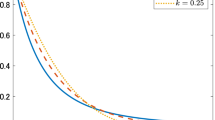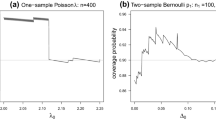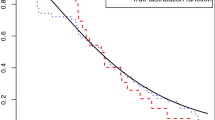Abstract
A myriad of physical, biological and other phenomena are better modeled with semi-infinite distribution families, in which case not knowing the population minimum becomes a hassle when performing parametric inference. Ad hoc methods to deal with this problem exist, but are suboptimal and sometimes unfeasible. Besides, having the statistician handcraft solutions in a case-by-case basis is counterproductive. In this paper, we propose a framework under which the issue can be analyzed, and perform an extensive search in the literature for methods that could be used to solve the aforementioned problem; we also propose a method of our own. Simulation experiments were then performed to compare some methods from the literature and our proposal. We found that the straightforward method, which is to infer the population minimum by maximum likelihood, has severe difficulty in giving a good estimate for the population minimum, but manages to achieve very good inferred models. The other methods, including our proposal, involve estimating the population minimum, and we found that our method is superior to the other methods of this kind, considering the distributions simulated, followed very closely by the endpoint estimator by Alves et al. (Stat Sin 24(4):1811–1835, 2014). Although these two give much more accurate estimates for the population minimum, the straightforward method also displays some advantages, so choosing between these three methods will depend on the problem domain.






Similar content being viewed by others
References
Alexopoulos, C., Goldsman, D., Mokashi, A.C., Tien, K.W., Wilson, J.R.: Sequest: a sequential procedure for estimating quantiles in steady-state simulations. Oper. Res. 67(4), 1162–1183 (2019)
Alves, I.F., Neves, C.: Estimation of the finite right endpoint in the gumbel domain. Stat. Sin. 24(4), 1811–1835 (2014)
Alves, I.F., de Haan, L., Neves, C.: How far can man go? In: Torelli, N., Pesarin, F., Bar-Hen, A. (eds) Advances in Theoretical and Applied Statistics, pp. 187–197. Springer, Berlin (2013)
Alves, I.F., Neves, C., Rosário, P.: A general estimator for the right endpoint with an application to supercentenarian women’s records. Extremes 20(1), 199–237 (2017)
Anderson, D., Burnham, K.: Model Selection and Multi-model Inference. Springer, Berlin (2004)
Athreya, K.B., Fukuchi, J.i.: Confidence intervals for endpoints of a cdf via bootstrap. J. Stat. Plan. Inference 58(2), 299–320 (1997)
Beirlant, J., Goegebeur, Y., Segers, J., Teugels, J.L.: Statistics of Extremes: Theory and Applications. Wiley, New York (2004)
Beirlant, J., Bouquiaux, C., Werker, B.J.: Semiparametric lower bounds for tail index estimation. J. Stat. Plan. Inference 136(3), 705–729 (2006)
Beranger, B., Padoan, S.A., Sisson, S.A.: Estimation and uncertainty quantification for extreme quantile regions. Extremes 24(2), 349–375 (2021)
Cai, J.J., de Haan, L., Zhou, C.: Bias correction in extreme value statistics with index around zero. Extremes 16(2), 173–201 (2013)
Chung, J., Kannappan, P., Ng, C., Sahoo, P.: Measures of distance between probability distributions. J. Math. Anal. Appl. 138(1), 280–292 (1989)
Cordeiro, G.M., de Castro, M.: A new family of generalized distributions. J. Stat. Comput. Simul. 81(7), 883–898 (2011)
Daouia, A., Simar, L.: Nonparametric efficiency analysis: a multivariate conditional quantile approach. J. Econom. 140(2), 375–400 (2007)
Dekkers, A.L., Einmahl, J.H., De Haan, L.: A moment estimator for the index of an extreme-value distribution. Ann. Stat. 17(4), 1833–1855 (1989)
Diebolt, J., Gardes, L., Girard, S., Guillou, A.: Bias-reduced estimators of the weibull tail-coefficient. TEST 17(2), 311–331 (2008)
Dierckx, G., Beirlant, J., De Waal, D., Guillou, A.: A new estimation method for weibull-type tails based on the mean excess function. J. Stat. Plan. Inference 139(6), 1905–1920 (2009)
Drees, H.: On smooth statistical tail functionals. Scand. J. Stat. 25(1), 187–210 (1998)
Drees, H., et al.: Extreme quantile estimation for dependent data, with applications to finance. Bernoulli 9(4), 617–657 (2003)
Falk, M.: Some best parameter estimates for distributions with finite endpoint. Stat. J. Theor. Appl. Stat. 27(1–2), 115–125 (1995)
Ferreira, A., Haan, L.d., Peng, L.: On optimising the estimation of high quantiles of a probability distribution. Statistics 37(5), 401–434 (2003)
Gardes, L., Girard, S., Guillou, A.: Weibull tail-distributions revisited: a new look at some tail estimators. J. Stat. Plan. Inference 141(1), 429–444 (2011)
Gibbs, A.L., Su, F.E.: On choosing and bounding probability metrics. Int. Stat. Rev. 70(3), 419–435 (2002)
Girard, S., Guillou, A., Stupfler, G.: Estimating an endpoint with high-order moments. Test 21(4), 697–729 (2012)
Girard, S., Guillou, A., Stupfler, G.: Estimating an endpoint with high order moments in the weibull domain of attraction. Stat. Probab. Lett. 82(12), 2136–2144 (2012)
Goegebeur, Y., Beirlant, J., De Wet, T.: Generalized kernel estimators for the Weibull-tail coefficient. Commun. Stat. Theory Methods 39(20), 3695–3716 (2010)
Goldberg, D.E.: Fundamentals of Chemistry. McGraw-Hill, New York (2006)
Goldenshluger, A., Tsybakov, A.: Estimating the endpoint of a distribution in the presence of additive observation errors. Stat. Probab. Lett. 68(1), 39–49 (2004)
Haan, L.D., Ferreira, A.: Extreme Value Theory: An Introduction. Springer, Berlin (2006)
Haan, L., Stadtmüller, U.: Generalized regular variation of second order. J. Aust. Math. Soc. 61(3), 381–395 (1996)
Hall, P.: On estimating the endpoint of a distribution. Ann. Stat. 10(2), 556–568 (1982)
Hall, P., Park, B.U.: New methods for bias correction at endpoints and boundaries. Ann. Stat. 30(5), 1460–1479 (2002)
Hall, P., Wang, J.Z.: Estimating the End-Point of a Probability Distribution Using Minimum-Distance Methods, pp. 177–189. Bernoulli, Basel (1999)
Hellinger, E.: Die orthogonalinvarianten quadratischer formen von unendlichvielen variabelen. Ph.D. thesis, University of Göttingen (1907)
Hill, B.M.: A simple general approach to inference about the tail of a distribution. Ann. Stat. 3(5), 1163–1174 (1975)
Hosking, J.R., Wallis, J.R.: Parameter and quantile estimation for the generalized pareto distribution. Technometrics 29(3), 339–349 (1987)
Jenkinson, A.F.: The frequency distribution of the annual maximum (or minimum) values of meteorological elements. Q. J. R. Meteorol. Soc. 81(348), 158–171 (1955)
Kahaner, D., Moler, C., Nash, S.: Numerical Methods and Software. Prentice-Hall, London (1989)
Lawless, J.F.: Statistical Models and Methods for Lifetime Data. Wiley, New York (2003)
Leng, X., Peng, L., Wang, X., Zhou, C.: Endpoint estimation for observations with normal measurement errors. Extremes 22(1), 71–96 (2019)
Li, D., Peng, L.: Does bias reduction with external estimator of second order parameter work for endpoint? J. Stat. Plan. Inference 139(6), 1937–1952 (2009)
Li, D., Peng, L.: Comparing extreme models when the sign of the extreme value index is known. Stat. Probab. Lett. 80(7–8), 739–746 (2010)
Li, Z., Peng, L.: Bootstrapping endpoint. Sankhya A 74(1), 126–140 (2012)
Li, D., Peng, L., Qi, Y.: Empirical likelihood confidence intervals for the endpoint of a distribution function. TEST 20(2), 353–366 (2011)
Li, D., Peng, L., Xu, X.: Bias reduction for endpoint estimation. Extremes 14(4), 393–412 (2011)
Lindsay, B.G.: Mixture models: theory, geometry and applications. In: NSF-CBMS Regional Conference Series in Probability and Statistics, pp. i–163. JSTOR (1995)
Loh, W.Y.: Estimating an endpoint of a distribution with resampling methods. Ann. Stat. 12(4), 1543–1550 (1984)
Meister, A., Neumann, M.H.: Deconvolution from non-standard error densities under replicated measurements. Stat. Sin. 20(4), 1609–1636 (2010)
Methni, J.E., Gardes, L., Girard, S., Guillou, A.: Estimation of extreme quantiles from heavy and light tailed distributions. J. Stat. Plan. Inference 142(10), 2735–2747 (2012)
Mood, A.M.: Introduction to the Theory of Statistics. McGraw-Hill, New York (1950)
Mudholkar, G.S., Srivastava, D.K.: Exponentiated Weibull family for analyzing bathtub failure-rate data. IEEE Trans. Reliab. 42(2), 299–302 (1993)
Müller, S., Hüsler, J.: Iterative estimation of the extreme value index. Methodol. Comput. Appl. Probab. 7(2), 139–148 (2005)
Pickands, J.: Statistical inference using extreme order statistics. Ann. Stat. 3(1), 119–131 (1975)
Royden, H.L.: Real Analysis. Prentice Hall, London (1988)
Smith, R.L.: Maximum likelihood estimation in a class of nonregular cases. Biometrika 72(1), 67–90 (1985)
Smith, R.L.: Estimating tails of probability distributions. Ann. Stat. 15(3), 1174–1207 (1987)
Stacy, E.W., Mihram, G.A.: Parameter estimation for a generalized gamma distribution. Technometrics 7(3), 349–358 (1965)
Stefanski, L.A., Carroll, R.J.: Deconvolving kernel density estimators. Statistics 21(2), 169–184 (1990)
Torabi, H., Montazeri, N.H.: The logistic-uniform distribution and its applications. Commun. Stat. Simul. Comput. 43(10), 2551–2569 (2014)
Vaart, A.W.V.D.: Asymptotic Statistics, vol. 3. Cambridge University Press, Cambridge (2000)
Valk, C.d.: Approximation and estimation of very small probabilities of multivariate extreme events. Extremes 19(4), 687–717 (2016)
Valk, C.d.: Approximation of high quantiles from intermediate quantiles. Extremes 19(4), 661–686 (2016)
Valk, C.D., Cai, J.: A high quantile estimator based on the log-generalized Weibull tail limit. Econom. Stat. 6, 107–128 (2018)
Vapnik, V.N.: Statistical Learning theory. Wiley, Berlin (1998)
Wang, F., Peng, L., Qi, Y., Xu, M.: Maximum penalized likelihood estimation for the endpoint and exponent of a distribution. Stat. Sin. 29(1), 203–224 (2019)
Yazidi, A., Hammer, H.: Multiplicative update methods for incremental quantile estimation. IEEE Trans. Cybern. 49(3), 746–756 (2017)
Acknowledgements
We are grateful to prof. Ricardo Marcacini for valuable suggestions, as well as the LaSDPC and BioCom laboratories for the computational and other resources. We also thank the Coordination for the Improvement of Higher Education Personnel (CAPES) for the financial support and also CeMEAI (FAPESP Grant 2013/07375-0) for providing access to their supercomputer.
Funding
This project is funded by the Coordination for the Improvement of Higher Education Personnel (CAPES).
Author information
Authors and Affiliations
Contributions
MHJ Saldanha and AK Suzuki were involved in conceptualization, methodology and formal analysis and investigation; MHJ Saldanha wrote and prepared the original draft, prepared the materials and collected the data; and AK Suzuki was responsible for writing, reviewing and editing, and supervision.
Corresponding author
Ethics declarations
Conflict of interest
The authors declare there is no conflict of interest.
Code availability
The appropriate computer programs were submitted with this paper for review.
Additional information
Publisher's Note
Springer Nature remains neutral with regard to jurisdictional claims in published maps and institutional affiliations.
Rights and permissions
About this article
Cite this article
Saldanha, M.H.J., Suzuki, A.K. On dealing with the unknown population minimum in parametric inference. AStA Adv Stat Anal 107, 509–535 (2023). https://doi.org/10.1007/s10182-022-00445-9
Received:
Accepted:
Published:
Issue Date:
DOI: https://doi.org/10.1007/s10182-022-00445-9
Keywords
- Population minimum
- Endpoint estimation
- Parameter inference
- Maximum likelihood estimation
- Extreme value theory
- Extreme quantile estimation




